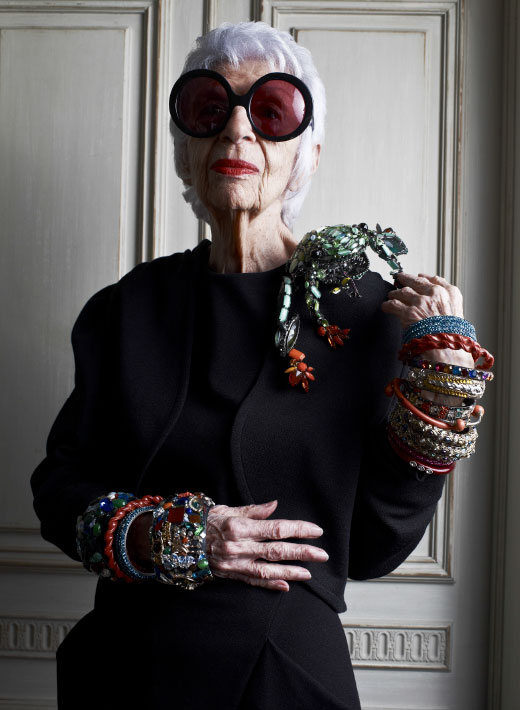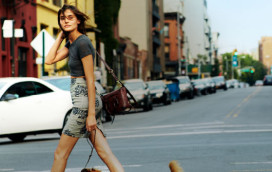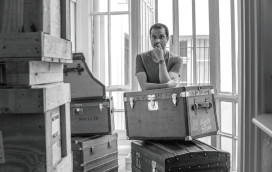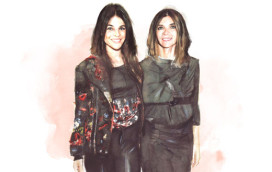Iris, you were born and raised in New York, right?
I was raised in Astoria, Queens, and lived there until I married. My grandparents were settlers, actually, and caught the boat here from Long Island.
What memories do you have of coming to the city as a child?
Well, the city was the mecca. You would go there for shopping, or an event such as the Easter Parade – everybody in their spring finery, looking swell. In those days you wouldn’t see a person walking on Fifth Avenue without a hat and gloves. Today you’re lucky if they have shoes.
I remember a story you told me about your first experience shopping alone in the city…
Yes, I was 11 years old. It was Easter time and I needed a new outfit and bonnet, but my mother had no time to go shopping with me. So she gave me $25 to go into the city by myself. I went to S. Klein and found a dress that I just flipped over. All silk, poet sleeves, with a tie front, for only $12.95. I gave thanks to God and $12.95 to the cashier, and then went to A.S. Beck and got a smashing pair of shoes for $3.98. I had enough left for a nice little lunch and the bus home. My mother approved of my sense of style and my dad approved of my economical choices. My grandfather, who was a master tailor, was the only one who was not impressed.
Where were the memorable places that you lived in New York?
After I got married I moved into the city. I haven’t moved around that much, but before living here, we had a great townhouse on 79th Street. What we had in charm we lacked in plumbing. Nothing worked, but it was fabulous.
In what decade or era would you say New York was at its most elegant?
The late 1940s or 1950s, before the youth revolution. It was glamour; glamour doesn’t exist any more. People like glamour – especially men. I think men are more romantic than women, anyway.
Did you have any favorite spots in the city during that era?
Oh, there was fabulous nightlife, glamorous clubs like the Copacabana – where, if you were lucky, you could sit ringside and touch Frank Sinatra. Great jazz clubs, restaurants… Henri Soulé ran an extraordinary French restaurant called Le Pavillon. They all had dress codes – you couldn’t go in looking like a slob. It was nice to have people looking elegant. They always had a coat and tie rack for men who came in without them, and nothing would fit, so they’d sit there looking like the village idiot or a grade-school dunce. There was also Ben Marden’s Riviera in New Jersey. Everyone used to go. Lucille Ball was in the chorus. People also entertained at their homes beautifully. Guests came dressed to the nines. There was an article of clothing called the “hostess gown,” which you don’t see any more.
Did you frequent any of New York’s great jazz clubs?
El Morocco and the Stork Club. Fifty-Second Street was very important in the 1940s – the whole street, with one place next to another. I had a boyfriend who was mad for Billie Holiday so we used to go there all the time.
Do you have any fond memories of The St. Regis New York?
It was always a very beautiful hotel, and we used to go to the King Cole Bar there. It was a place for people to meet.
When you’re in New York these days, where do you like to go? We love to eat at
La Grenouille – it’s very old-world, very elegant. People come well dressed, the floral arrangements are spectacular and the food is divine… and yet it’s very natural. Some of these new restaurants that are so la-di-da are very pretentious.
Where do you like to shop today in the city?
I don’t shop very much. I don’t need to shop, I’ve got so much. But New York does have great discount stores, like Loehmann’s, and great sample sales.
What’s a highlight of your career?
We did major work at the White House, through more than nine administrations. We did many historic restorations: the Renwick Gallery, Blair House, the Senate, the State Department, Theodore Roosevelt’s birthplace and the Decatur House, among others.
At 91, you have a whole new career as a spokeswoman, model, teacher and fashion icon…
Oh, it’s hysterical – the other night I did a personal appearance at Bloomingdale’s for my new handbag collection, and people were lining up. I’m the same as I ever was but all of a sudden I’m cool. It’s almost embarrassing. My husband and I think it’s very funny, but I also think it’s very sweet. I’m touched that at this stage of my life I’m having so much fun.
What projects are you working on?
I’ve done a line of sunglasses and readers for Eyebobs. I have a collection of purses called Extinctions, and a new line of shoes for HSN. I did a collection with MAC cosmetics and I’ve also been working on a perfume. I teach visiting students as a professor for the University of Texas, which keeps me very busy.
How did you feel when MAC approached you?
I thought it would be fun. When I do these things I really put work into it, choosing the colors and textures. I don’t just put my name on it. And a bonus is that I’ve met some very nice people from it.
Do you feel that you have helped in some way to alter the perception of ageing in popular culture?
I hope so; I think so. Maybe that’s one of the reasons I’ve become so popular, because I’m so old. I’m a cover girl in my dotage, a geriatric starlet. The world’s oldest living teenager.
What do you love about being in New York?
There’s no place in the world like New York. If you can’t find it in New York, it doesn’t exist. It’s the heartbeat of the world.
What advice do you have for someone visiting New York?
You have to be like a sponge and soak it all up. It’s a walking city with some of the best museums and shops, with everything you might want to buy, whether you need it or not. Every kind of food you might want to taste is here. And it all exists in all price ranges. What’s the Sinatra song… if I can make it there, I’ll make it anywhere.
So, where do you want to retire?
I don’t want to retire ever. I think retirement is a fate worse than death.
advancedstyle.blogspot.com
I am a Cover Girl in my Dotage
Interior designer, fashionista, socialite and style icon, Iris Apfel, 91, explains
why her heart still beats to the rhythm of New York City
- Interview by Ari Seth Cohen
- Photograph by Trunk Archive
Iris Apfel"I’m a cover girl in my dotage, a geriatric starlet. The world’s oldest living teenager"



